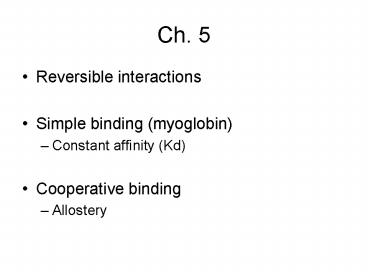Ch. 5 - PowerPoint PPT Presentation
1 / 19
Title: Ch. 5
1
Ch. 5
- Reversible interactions
- Simple binding (myoglobin)
- Constant affinity (Kd)
- Cooperative binding
- Allostery
2
Ch. 5
- Cooperativity
- Multiple binding sites
- Two states high affinity (R for Hb) low (T)
- Different factors influence the R?T equil
- Oxygen allosteric activator (positive)
- BPG, H, etc. allosteric inhibitors
3
Chapter 6 3/16, 19, 21, 26, 27, 28
- Catalysis in general
- Activation energy (EA or DG ) is a kinetic
barrier to reaction - Enzymes lower this barrier (dont change DG or
the equilibrium constant) - Create a new reaction pathway with better DH or
(and) better DS
4
Chapter 6
- General types of catalysis (how do enzymes change
the reaction pathway?) - General acid/base
- Donate/accept protons from a substrate
(substrates) - Many times water (activation of water)
- Covalent catalysis
- Metal ion catalysis
- Stabilize (slightly) negatively charged
intermediates (ie. lower H of transition state) - Oxidation/reduction
5
Chapter 6
- Quantification of catalysis
- Km
- Vmax/kcat
- kcat/Vmax
- Ki
- Michaelis-Menten kinetics
- Lineweaver-Burk plots
6
Chapter 6
- Enzyme regulation
- Why?
- How?
7
Ch.7 4/13, 16
- Carbohydrates (sugars)
- Polyhydroxy ketone OR aldehyde
- Named ose
- Typically a ring structure
- -OH attack on carbonyl carbon creates a
hemiacetal or hemiketal - Makes an anomeric carbon new stereocenter
- Capable of mutarotation
8
Ch.7
- Cyclic sugars chair form, not flat
- Hemiacetal/ketal can be attacked by another
hydroxyl group full ace-/ke-tal
Often another sugar glycosidic bond/polymerizatio
n Disaccharide/polysaccharides
9
Ch.7
- Sugars as energy sources
- Highly polymerized, starch/glycogen
- Structural sugars
- Cellulose, chitin
- Sugar/peptide conjugates
- Peptido/proteoglycans
- Mainly sugar biological activity modified by
protein attachment - Glycoproteins
- Mainly proteins bio activity modified by sugars
10
Ch.8 4/17, 18
- Nucleotides/nucleic acids
- Different functions
- ATP, etc
- Signal transduction (cAMP, etc)
- Coenzymes (NADH, etc)
- Information transfer, storage
- Components of proteins (RNA-containing proteins)
11
- Structure of nucleotides
- Structure of nuc acids
- Base pairing weak
- interactions
- Hbonding/stacking (vdW)
- Antiparallel
- Melting point determined by?
- RNA ss, but still base pairs
- Secondary structure
12
Ch.8
- Consequences of covalent modification of DNA
(RNA?) mutation - Base deamination
- Depurination (removal of the base)
- Dimerization of pyrimidines
- Oxidative damage
- Other functions of nucleotides
13
Ch.10 114/23, 24, 25, 30
- Fatty acids
- Melting points?
- Modification of the carboxylic acid
- Lipid structure, esp glycophospholipids
- Fluid mosaic model
- Roles of lipids (why different types/dynamics?)
- Membrane fluidity
- Activity of integral membrane proteins
- Attraction of peripheral memb proteins
- Precursors to other molecules vitamins,
signaling molecules, hormones
14
Ch. 1011
- Cholesterol
- Membrane component, precursor to steroids
- Fat-soluble vitamins
- D (derived from cholesterol regulates Ca2
uptake, etc) - A (retinol visual pigment, regulates gene
expression (skin plasticity)) - E (antioxidant, protects membrane lipids from
free radical damage) - K (coenzyme, processing of blood clotting
proteins)
15
Ch. 1011
- Membranes
- Lipid bilayer fluid mosaic
- Lateral diffusion is easy (in general)
- Transverse diffusion (flip-flop) is slow (sans
catalysis) - Integral/peripheral membrane proteins
- Membrane asymmetry/modification of fluidity
- Inner/outer leaflets different lipids
- Lipid rafts keep multiprotein complexes together
- Intracellular anchoring of memb proteins
16
Ch.1011
- Concept of hydropathy plots to predict integral
membrane proteins - Membrane fusion
- Regulated exocytosis
- Problems?
- Solute movement through membranes
- Diffusion
- Simple vs. facilitated
- Active transport
17
Ch.13
- Bioenergetics
- DG stuff
- ATP as a good energy storage molecule
- Other energy storage molecules
- Creation of ATP
- Slow (ie. respiration)
- Fast (eg. creatine kinase)
- Use of ATP (not just parallel hydrolysis)
- Redox
- Terminology (oxidation/reduction/oxidizing
agt/etc) - Pos DE neg DG
18
Aerobic respiration of glucose
- Glycolysis
- Start with glucose (6 carbon)
- Generate some ATP, some NADH, pyruvate (2 x 3
carbon) - Regeneration of NAD in absence of O2
(fermentation) - TCA cycle
- Start with pyruvate
- Generate acetate (acetyl CoA)
- Generate CO2 and reduced NADH and FADH2
- Electron transport
- Start with NADH/FADH2
- Generate electrochemical H gradient
- Oxidative phosphorylation
- Start with H gradient and O2 (and ADP Pi)
- Generate ATP and H2O
19
(No Transcript)































